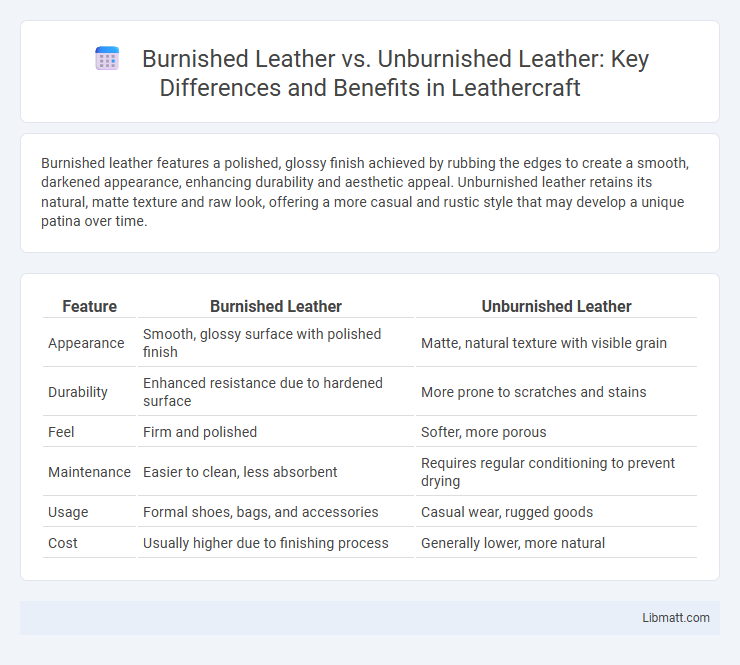Burnished leather features a polished, glossy finish achieved by rubbing the edges to create a smooth, darkened appearance, enhancing durability and aesthetic appeal. Unburnished leather retains its natural, matte texture and raw look, offering a more casual and rustic style that may develop a unique patina over time.
Table of Comparison
| Feature | Burnished Leather | Unburnished Leather |
|---|---|---|
| Appearance | Smooth, glossy surface with polished finish | Matte, natural texture with visible grain |
| Durability | Enhanced resistance due to hardened surface | More prone to scratches and stains |
| Feel | Firm and polished | Softer, more porous |
| Maintenance | Easier to clean, less absorbent | Requires regular conditioning to prevent drying |
| Usage | Formal shoes, bags, and accessories | Casual wear, rugged goods |
| Cost | Usually higher due to finishing process | Generally lower, more natural |
Introduction to Burnished and Unburnished Leather
Burnished leather features a polished, glossy surface achieved through a mechanical or chemical finishing process that enhances durability and aesthetic appeal. Unburnished leather retains its natural, matte texture, offering a more organic look and a softer feel while maintaining breathability and flexibility. The choice between burnished and unburnished leather impacts product longevity, maintenance, and style preferences in fashion and furniture applications.
What is Burnished Leather?
Burnished leather is a type of leather that has been polished and treated to create a smooth, shiny surface with a rich, deep color. This effect is achieved by rubbing the leather's edges or surface with an abrasive material or a burnishing tool, enhancing its durability and aesthetic appeal. Compared to unburnished leather, burnished leather offers a more refined look and improved resistance to wear and moisture.
What is Unburnished Leather?
Unburnished leather is a type of leather that has not undergone the burnishing process, leaving its surface matte and more natural with a rougher texture. This leather retains its original fibrous quality, which makes it more breathable and flexible compared to burnished leather. You can expect unburnished leather to develop a unique patina over time, enhancing its rustic and authentic appearance naturally.
Key Differences: Burnished vs Unburnished Leather
Burnished leather features a polished, shiny surface achieved by rubbing and sealing the edges, enhancing durability and a refined appearance, while unburnished leather has a natural, matte finish with visible textures and a softer, more casual feel. The burnishing process also makes burnished leather more resistant to moisture and wear, making it ideal for dress shoes and high-end accessories. Your choice depends on whether you prefer a sleek, protective finish or a raw, rustic aesthetic.
Visual Appearance and Finish Comparison
Burnished leather features a polished, glossy surface achieved through a rubbing process that intensifies color depth and highlights natural grain patterns, giving it a sleek, sophisticated appearance. Unburnished leather has a matte finish with a softer, more natural look, showcasing the leather's texture and imperfections for a rustic or vintage aesthetic. The burnishing process enhances durability and resistance to scuffs, while unburnished leather offers a more traditional, unfinished feel that ages with character over time.
Durability and Longevity Factors
Burnished leather exhibits enhanced durability due to its polished surface, which adds an extra layer of protection against scratches and moisture. Unburnished leather tends to have a more natural, untreated finish, making it more susceptible to wear and staining over time. Your choice between burnished and unburnished leather should consider the balance between aesthetic preference and the leather's expected lifespan in daily use.
Care and Maintenance Requirements
Burnished leather requires regular polishing and conditioning to maintain its glossy finish and protect against cracking, while unburnished leather demands more frequent cleaning and conditioning to prevent drying and staining due to its raw surface. Both types benefit from avoiding excessive moisture and direct sunlight, but burnished leather's smooth surface tends to resist dirt more effectively than the porous texture of unburnished leather. Proper care for either leather type extends durability and preserves aesthetic qualities, with burnished leather needing less intensive upkeep compared to the higher maintenance required by unburnished leather.
Common Uses and Applications
Burnished leather is commonly used in high-end shoes, belts, and handbags due to its polished, glossy finish that enhances aesthetic appeal and durability. Unburnished leather finds frequent application in casual footwear, work boots, and rustic-style accessories because of its natural, matte texture and breathability. Your choice between these types depends on the desired look and function, with burnished leather suited for stylish, formal items and unburnished leather for rugged, everyday use.
Pros and Cons of Burnished and Unburnished Leather
Burnished leather offers a sleek, polished look and greater water resistance due to its smooth, treated surface, making it ideal for formal footwear, but it can show scratches more easily and requires regular maintenance to retain its shine. Unburnished leather provides a natural, matte finish with enhanced breathability and a soft, flexible feel, which develops a unique patina over time, though it is more susceptible to stains and requires careful protection from moisture. Your choice depends on whether you prioritize durability and elegance with burnished leather or comfort and a rugged aesthetic with unburnished leather.
Which Leather Type Should You Choose?
Burnished leather offers a glossy, polished finish that enhances durability and resists stains, making it ideal for formal footwear and high-end accessories. Unburnished leather provides a natural, matte appearance with a softer texture, preferred for casual items and those valuing a more organic look. Choose burnished leather for elegance and longevity, while unburnished leather suits comfort and a rustic aesthetic.
Burnished leather vs unburnished leather Infographic

 libmatt.com
libmatt.com